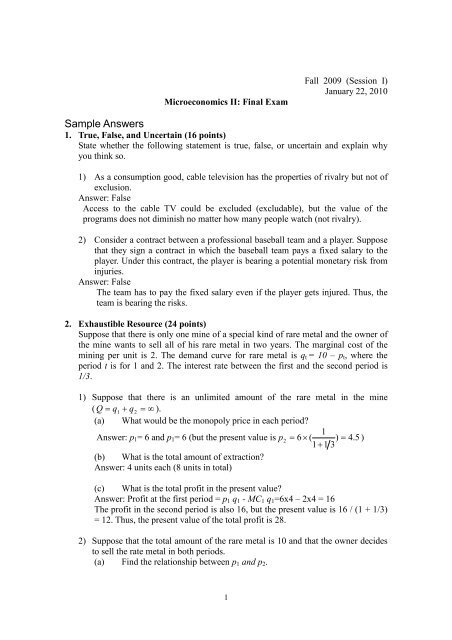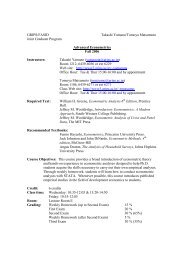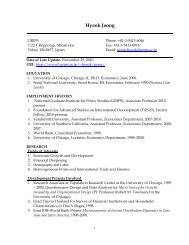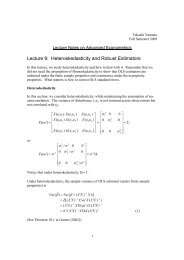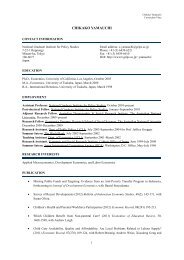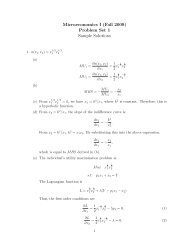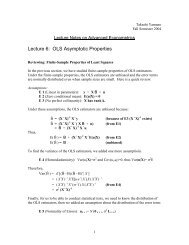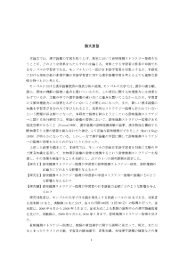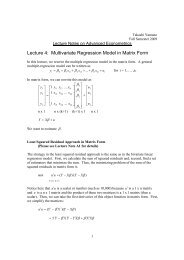Sample Answers
Sample Answers
Sample Answers
Create successful ePaper yourself
Turn your PDF publications into a flip-book with our unique Google optimized e-Paper software.
Microeconomics II: Final ExamFall 2009 (Session I)January 22, 2010<strong>Sample</strong> <strong>Answers</strong>1. True, False, and Uncertain (16 points)State whether the following statement is true, false, or uncertain and explain whyyou think so.1) As a consumption good, cable television has the properties of rivalry but not ofexclusion.Answer: FalseAccess to the cable TV could be excluded (excludable), but the value of theprograms does not diminish no matter how many people watch (not rivalry).2) Consider a contract between a professional baseball team and a player. Supposethat they sign a contract in which the baseball team pays a fixed salary to theplayer. Under this contract, the player is bearing a potential monetary risk frominjuries.Answer: FalseThe team has to pay the fixed salary even if the player gets injured. Thus, theteam is bearing the risks.2. Exhaustible Resource (24 points)Suppose that there is only one mine of a special kind of rare metal and the owner ofthe mine wants to sell all of his rare metal in two years. The marginal cost of themining per unit is 2. The demand curve for rare metal is q t = 10 – p t , where theperiod t is for 1 and 2. The interest rate between the first and the second period is1/3.1) Suppose that there is an unlimited amount of the rare metal in the mine( Q = q 1+ q2= ∞ ).(a) What would be the monopoly price in each period?1Answer: p 1 = 6 and p 1 = 6 (but the present value is p2= 6 × ( ) = 4. 5 )1+1 3(b) What is the total amount of extraction?Answer: 4 units each (8 units in total)(c) What is the total profit in the present value?Answer: Profit at the first period = p 1 q 1 - MC 1 q 1 =6x4 – 2x4 = 16The profit in the second period is also 16, but the present value is 16 / (1 + 1/3)= 12. Thus, the present value of the total profit is 28.2) Suppose that the total amount of the rare metal is 10 and that the owner decidesto sell the rate metal in both periods.(a) Find the relationship between p 1 and p 2 .1
Answer: The profit of the first period must be equal to the present value of thep2− 2profit of the second period: p1− 2 =1+1 34 84 2p1− + 2 = p2thus p2= p1−3 33 3(b) By using the resource constraint, 10 = q 1 + q 2 , find the first and secondprices.Answer: From the demand function, we have4 2 32 4q1 = 10 − p 1and q2= 10 − ( p1− ) = − p1.3 3 3 3Because that the total amount is 10, we have32 410 = q1+ q2= 10 − p1+ − p13 37 323p = 1332p1= = 4. 57 .7And4 2 4 32 2 38p2= p1− − = − = = 5.43 .3 3 3 7 3 7Thus,32 3838 32q1= 10 − = = 5.43 and q2= 10 − = = 4. 57 .7 77 7(c) What is the total profit in the present value?Answer: The profit in each period is32 38 18x38684π1= p1q1− MC q1= ( − 2) = = = 13.967 7 49 49and38 32 24x32768π2= p2q2− MC q2= ( − 2) = = = 15.67 .7 7 49 49Thus, the total profit is684 768 1 1260π1+ π2= + × = = 25.71.49 49 1+1/ 3 49This is smaller than the profit in the unlimited total amount case in Q2-1. Thus,it is more profitable for the mine firm to charge the monopoly price in eachperiod and extact only 8 units, instead of 10 units.2
3. Public Goods (24 points)1) The maximization problem is written as:Max w − g1)+ 2ln( g1+ g2) + ( w2− g2) + 2ln( g1+By taking the derivative with respect to g 1 (or g 2 ), we have2 2−1++ = 0.g1+ g2g1+ g2Rearranging givesG * = g1 + g2= 4.2) Individual 1’s maximization problem is:Max ( w1 − g1)+ a1ln( g1+ g2)So the first-order condition isa1−1+= 0,g + g(1g21from which we have individual 1’s reaction function: g1( g2) = a1− g2.Similarly,individual 2’s reaction function is given by g g ) = a − .22(1 2g1Case 1: a 1= a 2= aIn this case, the two reaction functions are identical. Thus, any pair ( g1,g2) thatsatisfies g 1+ g 2= a is a Nash equilibrium. In any equilibrium, a units of thepublic good is provided. If a = 2 for example, 2 units will be provided.Case 2: a1> a2In this case, the reaction functions of individuals 1 and 2 are respectivelyg1 ( g2) = a1− g2and g2( g1)= a2− g1. Suppose that individual 1 contributes g 1.First, if g1 ≥ a2, g 2( g 1) = 0 . Then, individual 1 contributes g1( 0)= a1.Therefore, a1is provided by individual 1.Next, if g1< a2, individual 2’s best response is to contributeg ( g = a − g . Let us g t ) denote the best response of individual 2 in2 1)212( g 112g1)round t. Then, we have g ( = a2− g1. Given g2= a2− g1, individual 1’sbest response is to contribute g1( a2− g1)= a1− a2+ g1. Given this, individual22’s best response is to contribute g2( a1− a2+ g1)= 2a2− a1− g1. If this isweakly less than zero, individual 2 contributes nothing, and individual 12contributes g1( 0)= a1. If g2> 0 , the process continues. In round t, individual2’s best response is expressed as g t2= ta2− ( t −1)a1− g1. Since a1> a2, theretexists t’ such that g2≤ 0 for all t ≥ t'. That is, the best response for individual 2at round t’ is contributing nothing. Given g 0 , individual 1 contributesg1( 0)= a1. (You can check that g t1= ( t −1)(a1− a2) + g1> 0 for all t.)You can also start with some 0 ≤ g2≤ 1 and get the same result. It is mucheasier to follow the process graphically and that suffices to solve this question.2=)3
For example, if a1= 2,a2= 1,individual 1 provides 2 units of the publicgood and individual 2 free rides.4. Adverse Selection (24 points)1) If the bank can distinguish between safe and risky borrowers, it can receive R s forcertain by lending $1 to safe borrowers. The cost per unit lent is one. By thebreak-even condition, we haveRs−1 = 0,or R s = 1.If the bank lends to a risky borrower, it can recover R r if the borrower is lucky,which occurs with probability 0.5, nothing if the borrower is unlucky, which alsooccurs with probability 0.5. Thus, the break-even condition is given by:0 .5( Rr−1)+ 0.5(0 −1)= 0,from which we have R r = 2.2) (a) The bank can recover R either if the borrower is safe or if the borrower is riskybut lucky, the probabilities of which are q and 0.5(1 – q), respectively. Otherwise,the bank incurs costs while receives nothing. The break-even condition is thusq ( R −1)+ 0.5(1 − q)(R −1)+ (1 − 0.5)(1 − q)(0−1)= 0 .By rearranging, we have2R(q)= .1+q(b) Safe borrowers will not borrow from the bank if their net returns are less than 0:211 .5 − < 0 ⇒ q < .1+q3Therefore, the critical level of q is q* = 1/3.[End]4


